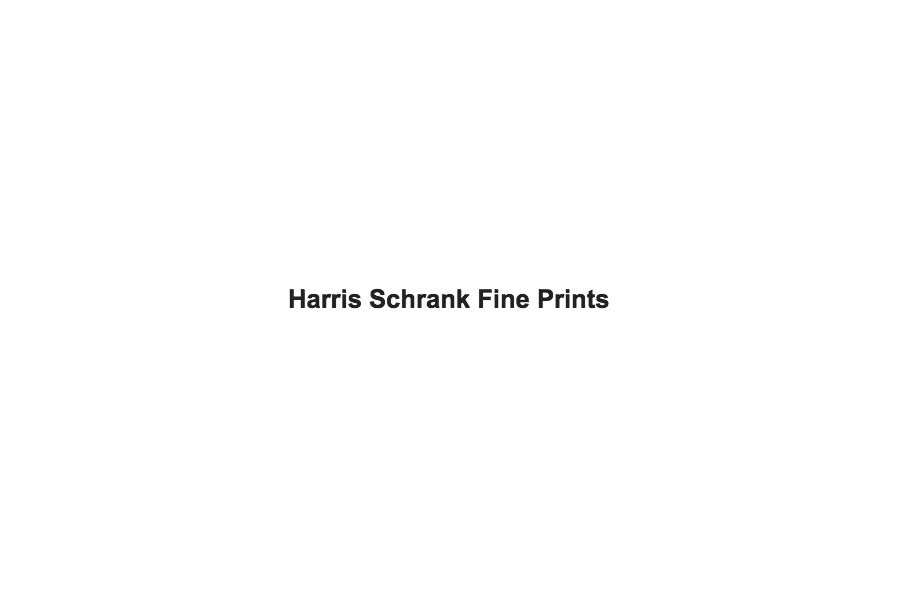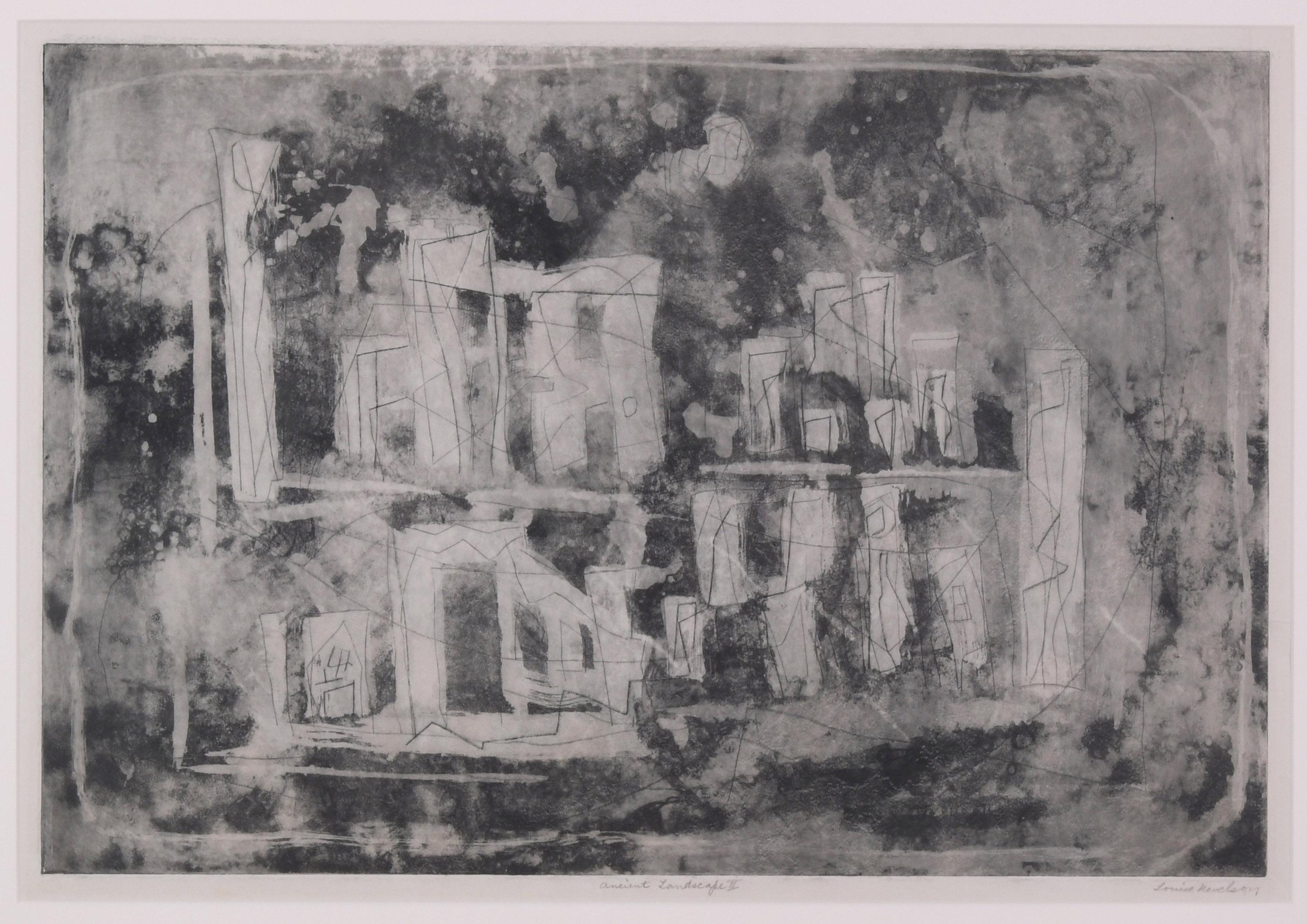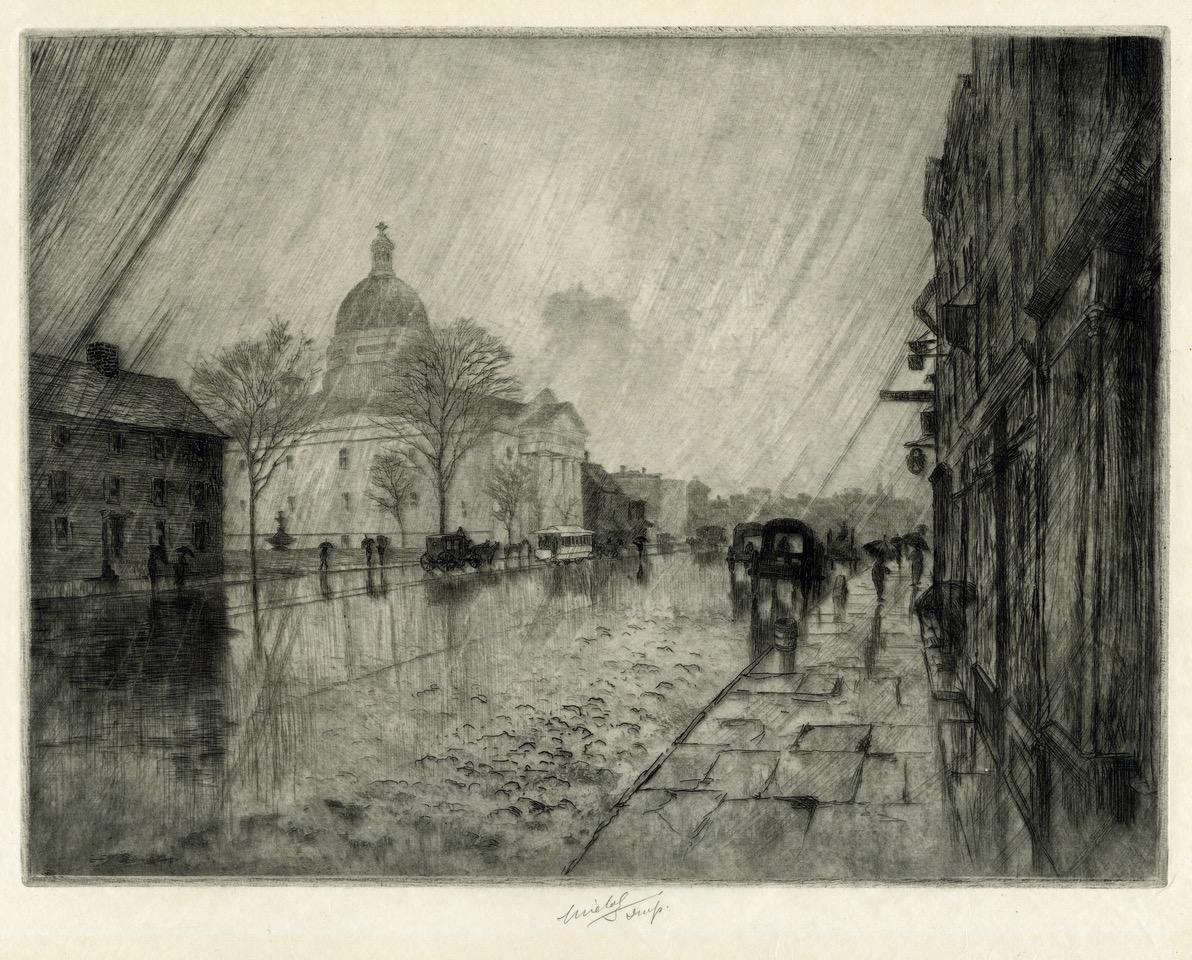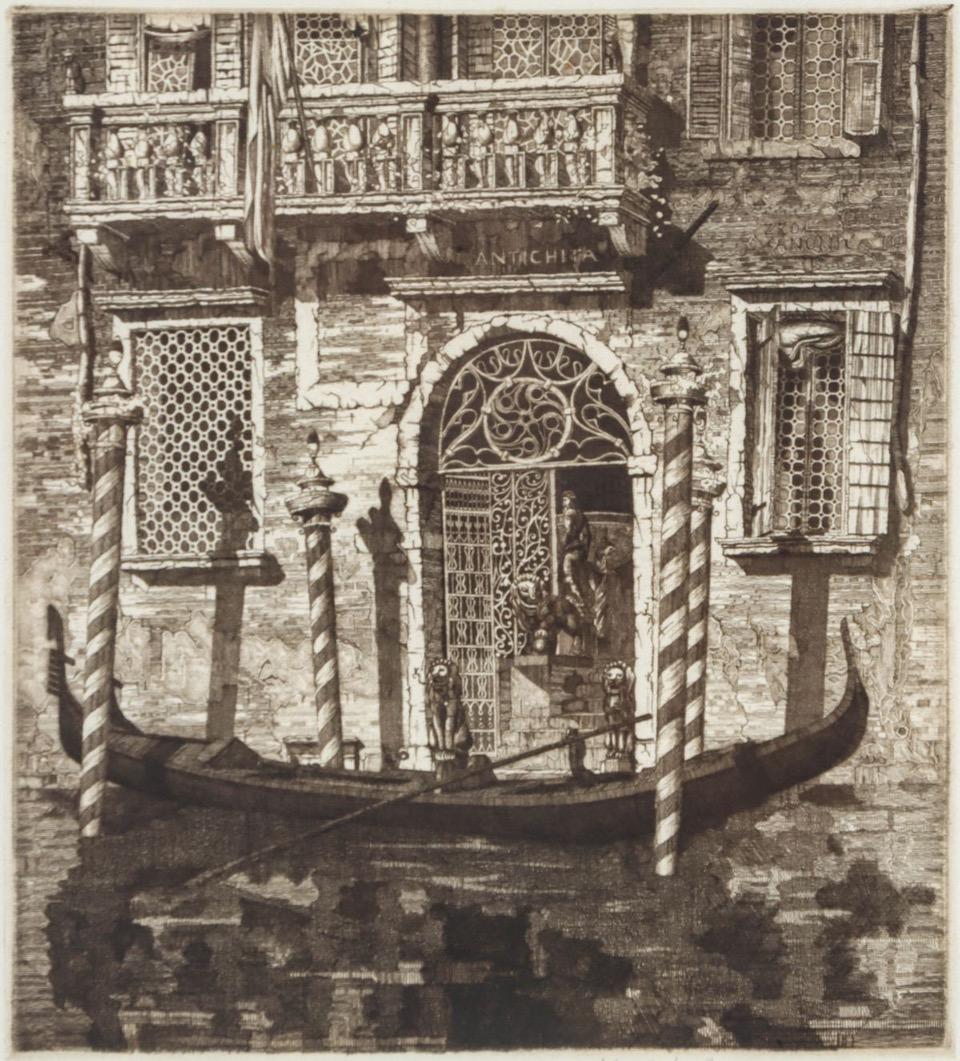Items Similar to Flatiron Building
Want more images or videos?
Request additional images or videos from the seller
1 of 2
William KentridgeFlatiron Building1985
1985
About the Item
William Kentridge (b. 1955), Flatiron Building, (also known as I Am Still Learning), drypoint, 1985, on Rives paper with their watermark, signed, dated and dedicated For Hermine from William ’86; inscribed AP lower left, in excellent condition, with full margins, 7 3/4 x 5 1/4, the sheet 13 1/4 x 9 1/2 inches.
Provenance: Gift of the artist
Estate of Hermine Chivian-Cobb, New York
Hermine Chivian-Cobb was a brilliant and highly regarded professional both as an art historian and a fine arts appraiser. Educated at Smith College, the Ecole du Louvre, and the Institute of Fine Arts of New York University, her broad knowledge of European art ranged from the 17th to the 20th century, including Russian painting and theater design. Her distinguished career included work at the Metropolitan Museum of Art, Sotheby’s, and Wildenstein Gallery.
This composition shows the artist in New York, his back turned to the viewer with his portfolio under his arm. He is seen walking away from the viewer precariously close to an open manhole. A warthog standing on the roof of a car in the foreground adds to the sense of alienation and displacement, felt by the artist struggling to find his place in an unfamiliar and congested environment. Of course in recent years Kentridge’s work has been heralded in New York – and beyond.
Flatiron Building is rare, only a few proofs are known, each inscribed AP (artist’s proof); we know of no edition.
- Creator:William Kentridge (1955, South African)
- Creation Year:1985
- Dimensions:Height: 7.75 in (19.69 cm)Width: 3.25 in (8.26 cm)Depth: 0.1 in (2.54 mm)
- Medium:
- Movement & Style:
- Period:
- Condition:
- Gallery Location:New York, NY
- Reference Number:1stDibs: LU515312241042

About the Seller
4.9
Recognized Seller
These prestigious sellers are industry leaders and represent the highest echelon for item quality and design.
Established in 2000
1stDibs seller since 2016
99 sales on 1stDibs
Typical response time: 3 hours
Associations
International Fine Print Dealers Association
- ShippingRetrieving quote...Ships From: New York, NY
- Return PolicyA return for this item may be initiated within 7 days of delivery.
More From This SellerView All
- Aux Approches de Madrid (also Aux Abords de la Ville)By Adolphe BeaufrèreLocated in New York, NYAdolphe-Marie Beaufrere (1876-1960), Aux Approches de Madrid (also Aux Abords de la Ville), drypoint, 1927, signed and numbered (14/55), from the edition of 55, with the blindstamp of Sagot, publisher (Lugt 2254). Reference: Morane 27-19. In good condition, on very thin cream Japan paper, 6 1/2 x 9, the sheet 8 3/8 x 11 1/4 inches, archival matting. A fine impression, with the drypoint burr extremely rich and effective (due in part to the use of a Japan paper, which tends to diffuse the ink surrounding the drypoint lines). Beaufrere was born at Quimperle, in Brittany, and though he traveled widely he re-connected with this area throughout his life. As a teenager he decided that he wanted to become an artist and he traveled to Paris where, shortly after his arrival, he encountered the eminent Gustave Moreau, who took him on as a student. Moreau encouraged him to study old master prints, especially the prints of Rembrandt and Durer, which were available in the Cabinet des Estampes in Paris – this was to be critical in his development. Beaufrere began printmaking in about 1904, with some woodcuts, but soon got into etching and engraving. Curiously, one of his colleague/teachers at the time was the Canadian etcher Donald Shaw MacLaughlan. He began showing his prints, with some success, but after his marriage in 1905, and with the urging of his new wife, moved out of Paris and back to Brittany. This move had a mixed effect on his career – contacts with other artists became fewer, but he did maintain gallery relationships, and the French countryside and it’s inhabitants would provide a continuing source of inspiration. During the Great War Beaufrere served in the infantry, and had few opportunities to make art. But he did study a volume of Rembrandt’s prints...Category
1920s Modern Landscape Prints
MaterialsDrypoint
- Battersea Morn (also Battersea Dawn)By James Abbott McNeill WhistlerLocated in New York, NYJames Whistler (1830-1903), Battersea Morn (also Battersea Dawn), drypoint, 1875, Kennedy 155, signed in pencil with the butterfly and inscribed “imp”. Kennedy 155, first state (of ...Category
1870s Impressionist Landscape Prints
MaterialsDrypoint
- The TraghettoBy James Abbott McNeill WhistlerLocated in New York, NYJames Whistler (1834-1903), The Traghetto, etching and drypoint, 1879-80, signed with the butterfly on the tab and inscribed “imp”. Reference: Kennedy 19...Category
1870s Impressionist Landscape Prints
MaterialsDrypoint, Etching
- J.H. Woods’ Fruit Shop, ChelseaBy James Abbott McNeill WhistlerLocated in New York, NYJames Whistler (1834-1903), J.H. Woods’ Fruit Shop, Chelsea, etching and drypoint, 1887-88. Signed with the butterfly on the tab and annotated “imp,” also signed with the butterfly in pencil verso and numbered “1”. References: Kennedy 265 second state (of 2), Glasgow 327 second state (of 4). Trimmed by the artist around the plate mark except for the tab, in excellent condition. Printed in black ink on ivory laid paper, 3 3/4 x 5 1/8 inches. A fine impression of this great rarity; the print was never published. Glasgow accounts for four impressions. watermark: partial arms of Amsterdam(cf. Spink/Stratis/Tedeschi, watermark nos. 12ff.) This is before the third state in which heavy shading was added around the woman at the center, and the heads of figures at right and left of the figure are defined. In Glasgow’s fourth state the shading and the figure were removed; no impression is known of this state, but the state is inferred from the cancelled plate. According to Glasgow “Joseph Henry Wood had a greengrocer’s shop at 1 Park Walk...Category
1880s Impressionist Landscape Prints
MaterialsDrypoint, Etching
- AntwerpBy Erich HeckelLocated in New York, NYErich Heckel (1883-1970), Antwerp, drypoint, 1914, signed and dated in pencil lower right margin. Reference: Dube 123. In excellent condition, the full sheet on a cream/ivory wove pa...Category
1910s Expressionist Landscape Prints
MaterialsDrypoint
- Laburnums and BatterseaBy Theodore Casimir RousselLocated in New York, NYTheodore Roussel, Laburnums and Battersea, etching and drypoint, 1889/1890 and 1898; signed in the plate lower right, and signed in pencil on the tab, with the inscription IMP. Hausb...Category
Late 19th Century Realist Landscape Prints
MaterialsEtching, Drypoint
You May Also Like
- Ancient Landscape II (Ancient City)By Louise NevelsonLocated in Fairlawn, OHAncient Landscape II (Ancient City) Etching and drypoint, 1953-55 Signed and titled in pencil by the artist (see photos) Annotated: "E130 A/1" in pencil lower right Estate stamp vers...Category
1950s American Modern Landscape Prints
MaterialsDrypoint
- Guardians of the Spire; Amiens Cathedral Number 2By John Taylor ArmsLocated in Middletown, NYGuardians of the Spire; Amiens Cathedral Number 2 New York: 1937. Etching and drypoint on watermarked F.J. Head cream-colored, antique laid paper, 6 3/4 ...Category
Mid-20th Century American Modern Figurative Prints
MaterialsDrypoint, Etching
- Rainy Day, ProvidenceLocated in Middletown, NYEtching with drypoint on Japan paper, 9 3/4 x 12 3/4 inches (245 x 322 mm), full margins, from an edition of approximately 50. Signed by the artist in pencil, lower center margin, t...Category
Early 20th Century American Modern Landscape Prints
MaterialsHandmade Paper, Drypoint, Etching
- Victoria Station (London)By Kenneth Holmes, A.R.C.A.Located in Middletown, NYA lovely dark and inky impression, signed by the artist. Drypoint etching on cream laid paper, 10 7/8 x 8 5/8 inches (275 x 218 mm), full margins. Signed in pencil, lower center marg...Category
Early 20th Century Modern Landscape Prints
MaterialsLaid Paper, Drypoint, Etching
- The Acropolis, AthensBy Louis Conrad RosenbergLocated in Middletown, NYEtching and drypoint on cream wove paper, full margins. Signed in pencil, lower right margin. In generally good conditon with several scattered very light spots of foxing throughout,...Category
1920s Modern Landscape Prints
MaterialsHandmade Paper, Drypoint, Etching
- Palazzo dell'AngeloBy John Taylor ArmsLocated in Middletown, NYPalazzo dell'Angelo 1931 Etching and drypoint on cream-colored, handmade laid paper with deckle edges, 7 1/4 x 6 3/4 inches (185 x 171 mm), edition of 100, full margins. Signed, dated and numbered "Ed. 100" in pencil, lower margin, second state (of three). Printed by Henry Carling, New York. Extremely minor mat tone and some inky residue in the top right corner, all unobtrusive and well outside of image area. An exquisite impression of this intricate image, with astonishing detail, and all the fine lines printing clearly. The image represents the first print which Arms printed on his own handmade paper. Framed handsomely with archival materials and museum grade glass in a wood gilt frame with a flower and garland motif. Illustrated: Dorothy Noyes Arms, Hill Towns and Cities of Northern Italy, p. 180; Anderson, American Etchers Abroad 1880-1930; Eric Denker, Reflections & Undercurrents: Ernest Roth and Printmaking in Venice, 1900-1940, p. 116. [Fletcher 233] Born in 1887 in Washington DC, John Taylor Arms studied at Princeton University, and ultimately earned a degree in architecture at the Massachusetts Institute of Technology in 1912. With the outbreak of W.W.I, Arms served as an officer in the United States Navy, and it was during this time that he turned his focus to printmaking, having published his first etching in 1919. His first subjects were the Brooklyn Bridge, near the Navy Yard, and it was during his wartime travel that Arms created a series of extraordinarily detailed etchings based on Gothic cathedrals and churches he visited in France and Italy. He used what was available to him, namely sewing needles and a magnifying glass, to create the incredibly rich and fine detail that his etchings are known for. Upon his return to New York after the war, Arms enjoyed a successful career as a graphic artist, created a series of etchings of American cities, and published Handbook of Print Making and Print Makers (Macmillan, 1934). He served as President of the Society of American Graphic Artists, and in 1933, was made a full member of the National Academy of Design. In its most modern incarnation, Palazzo dell'Angelo was constructed in or around 1570. The building, which has a rich and storied history, was erected upon the ruins of an earlier structure which predates the Gothic period. Some remnants of the earliest features of the residence were most certainly still visible when Arms visited, as they are today. Having a background in architecture, there's no question that Arms was moved by the beauty, history and ingenuity represented in the physical structure. One thing specifically gives away Arms's passion for the architecture, and that is the fact that he focused on the building's Moorish entranceway, balustrade, and two mullioned windows, and not on the curious Gothic era bas-relief of an angel nestled into the facade of the building, after which the structure is named. The sculpture itself doesn't appear in Arms's composition at all, despite the fact that it is the feature of the building that is most famous in its folklore. Arms instead focuses on the oldest portion of the architecture, even documenting some of the remnants of a fresco, and a funerary stele for the freedman Tito Mestrio Logismo, and his wife Mestria Sperata (visible above the water level, to the left of the door, behind the gondola), which was first described in 1436. Among the many notable bits of history regarding the Palazzo, it has been documented that Tintoretto painted frescos of battle scenes on the facade of the building. The paintings have been lost to time and the elements, but not entirely to history. The empty frame...Category
1930s American Modern Figurative Prints
MaterialsDrypoint, Etching
Recently Viewed
View AllMore Ways To Browse
Antique Currier And Ives Prints
Kasimir Etching
Currier And Ives Antique Prints
Sailboat Lithographs
Thomas Hart Benton Original
Metallic Screenprint
Dan Baldwin
Hiroshige Tokaido
One Hundred Views Of Edo
Modernist Elephant
Antique Prints New Orleans
Thomas Hart Benton Signed Lithograph
Christo Javacheff
Marine War Objects
India Coin
Vision Tiffany
Luigi Kasimir Etchings
Mardi Gras Painting





